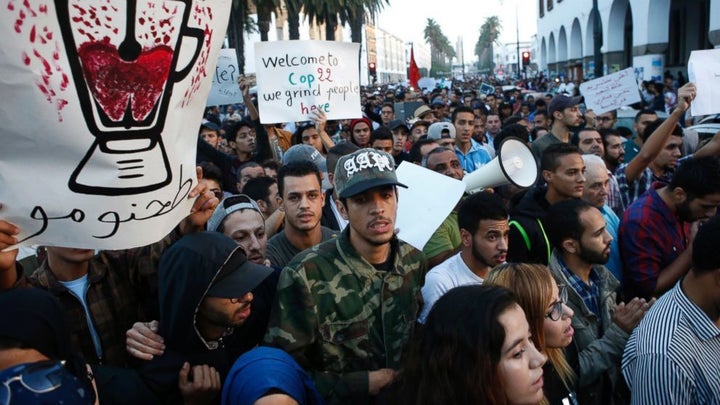
The tragic death of a fish vendor, Mohsin Fikri, in the northern Rif city of al-Hoceima has sent thousands of protesters to the streets in several major cities in Morocco. The 31-year-old vendor was selling fish on the street, when the police confiscated and threw his $11,000 merchandise in a garbage truck. The vendor then jumped into the garbage compactor to retrieve his fish where he was crushed to death. Since then, social media has been ablaze with indignation and calls for mobilization under the hashtag #t’han_mou (an expletive meaning ‘grind/crush his mother’), reportedly the final words Mohsin Fikri heard from the police officer who ordered the truck driver to operate the garbage compactor. In an attempt to placate increasing public anger and the protests that engulfed the entire country, high level officials traveled to the scene of the crime where they pledged to fully investigate the incident and hold those involved accountable. King Mohammed VI dispatched the ministry of the interior and pledged a “careful and in depth” investigation.
The protests on Sunday are the latest in several demonstrations and marches that have rocked Morocco, punctuated by several acts of individual resistance and self-immolations that took place since the Arab uprisings in 2011. In 2015, street vendors in Casablanca launched protests against police harassment. Earlier in 2016, student trainees marched in the thousands to protest against government decrees that placed limitation on teacher recruitment and cut teacher training grants by half. But the significance of these latest demonstrations is that they erupted in the city of al-Hoceima in the Rif region, which is known for its tumultuous history with the regime. In the 1920s its talismanic leader, Abdelkrim al-Khattabi, declared the independence of the Rif, which was short lived due to Spanish colonization. In the 1950s, the Rif was subjected to state repression after a violent rebellion was put down by then crown prince Moulay Hassan. Al-Hoceima also witnessed multiple casualties in the 2011 Arab uprisings protests.
As in past protests, Sunday’s demonstrations were a spontaneous collective reaction to the most pernicious aspects of state power, namely injustice, corruption, and daily denigration of Moroccans. Protesters in front of the parliament in Rabat chanted against the authoritarian structure of the makhzen: "Mohsin was killed & the makhzen is responsible." Moroccans have long abhorred hogra—Moroccan for extreme injustice -- that is seen as rampant in the state’s entrenched authoritarian edifice. Despite widely praised constitutional changes in 2011, and two rounds of legislative elections that buttressed Islamist PJD gains in government, much is still the same. Venality, nepotism, and lack of accountability are still chief grievances among a majority of Moroccans. According to the Arab Barometer III, 82 percent of Moroccans view the state as corrupt and 91 percent say that wasta, or nepotistic connections, is important for obtaining employment. In addition, the last few years saw a decline in individual and group freedoms in the kingdom. Public dissent of government is severely restricted, and freedom of the press has not been relaxed in regard to previous taboos and red lines. These limitations on the press have earned Morocco a press freedom status of “not free” in the 2016 Freedom House report.
The Party of Justice and Development, nominally in power today, has long pledged to fight corruption and injustice, but the pragmatic Islamist party has been caught in the dilemma of working within the system, and criticizing its most insidious aspects. The party leader and current head of the government, Abdelilah Benkirane’s dual strategy is manifest in this incident as he dispatched a high level PJD delegation led by Saad Eddine Othmani to meet with the family of the victim Mohsin Fikri, while at the same time calling on the legions of the party’s followers not to join the protests. This is hardly surprising from a party that rejected the February 20 protest movement’s call for demonstrations in 2011. Benkirane has always favored stability and has long thought that a PJD in the streets could be destabilizing to the political order. This is a role that fits with regime goals of placating the streets, but without a strong push from the Islamists, protests will likely dwindle in size and importance.
The appalling death of Mohsin Fikri has inevitably drawn comparisons to Mohamed Bou’azizi, the Tunisian fruit seller who self-immolated in 2010 sparking the Arab Spring uprisings. However, Fikri’s death will not be a Bou’azizi-like moment for Morocco. The regime will manage these latest manifestations of street anger by offering some sort of conciliatory approach to the demands of the protesters while working to limit the damage to the structure of the political order. The protests could have not come at a worse time for the state in Morocco, as it prepares itself and projects a positive image to the international community ahead of the COP22 climate change conference next week in Marrakech. Protesters have derisively brandished slogans that read: “Welcome COP22, we grind people here.” Several have also waved February 20 movement flags, symbolically invoking the continuity of the movement and its struggle against state corruption. But unless the latest manifestations avoid the pitfalls of the February 20 movement five years ago, no tangible changes would result.
In 2011, the February 20 movement failed as a transformational protest movement capable of articulating an alternative discursive challenge to the regime. The movement’s cycle of contention was nullified by state institutional and constitutional maneuvering, and the public’s apprehension of a Syria and Libya-like scenarios in Morocco. The protests were also beset by Moroccans’ binary view of the regime at a distance from the state in Morocco. The latest manifestations still feature that twin perception of the regime and state in Morocco, as the protesters have not been directing their ire at the institution of the monarchy, but at the authoritarian structure of the state around it.
Moroccans' daily life and the growing wealth gap in the country still provide the starkest reminder of hogra. Moroccans see the luxury cars, palaces, and other ostentatious accoutrements of wealth. These manifestations of opulence sharply juxtapose with the lives of many Moroccans who feel they lead an impoverished existence under systematic subjugation. Some of the slogans on Sunday crystallized that profound sense of deprivation. What Moroccans crave is fundamental change to government through rule of law and gradual shifts in the distribution of economic opportunities and political power. They know full well the monarchy is immune from any reproach and that deep meaningful reforms must start with the leviathan structure of the makhzen. In a country where there is a prevalent view that people are without a value to their state, the sad death of Mohsin Fikri in a garbage truck is poignantly evocative and further consolidates the public consciousness that, to a harshly autocratic state, Moroccans are largely disposable pieces of garbage.
